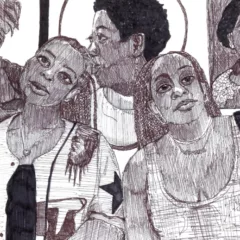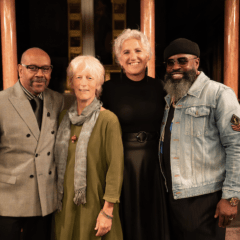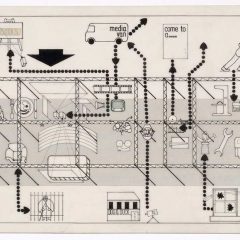During a week spent visiting buildings of Le Corbusier in France, one of the happiest surprises was the number of artists who have been invited to produce work in French monuments and sites. We began at the Villa Savoye in Poissy, just outside Paris. As we circumnavigated the building to reach the entrance (designed for visitors who arrive by car, the ‘front’ door is 180 degrees from the façade that’s visible on entering the grounds), we saw a large, open structure on the grounds, made of rough logs and thatch, that looked to me like an extravagant version of chickees, the thatched houses built by Seminoles in Florida, which have elevated platforms to raise them above the water of the Everglades.

There was no information on the structure, although the bookstore had leaflets on artists’ projects at the site, and someone was clearly working on something on the villa’s roof garden. A visit to the web revealed that we were a few days early for the opening of the installation, Sitio, by Santiago Borja, a Mexican artist well-connected to the international circuit of historical sites that have a history of inviting artists to respond to their buildings, collections and histories. The form of Borja’s outdoors structure (titled Destinerrance) was a doubled palapa, structures built in the Yucatan by the Mayans (hence the relationship with Seminole building); three traditional craftsmen from Mexico had come to Poissy to build Borja’s piece, which makes an association between the supporting logs of indigenous Mayan buildings and Le Corbusier’s famous pilotis, the stilts which raise the bulk of his buildings above ground level. The two other parts of Borja’s project, to be situated in the living room and on the villa’s terrace, were not completed when we visited.
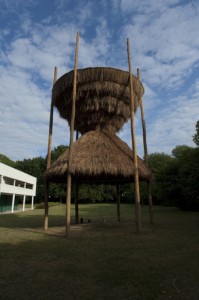
Borja has also produced work for the Freud Museum, London , the Swiss Pavilion at Cité Internationale Universitaire de Paris (more on that below), and Richard Neutra’s VDL-Research House II in L.A.. The Villa Savoye project is sponsored by the Graham Foundation and the regional department of monuments’ program, Balades en Yvelines, both of which have many art projects in the works and appear to give the artists appropriate budgets with which to work; the artists who have worked for Landmarks Contemporary Projects, Philadelphia, have done some very interesting work, but on a shoestring, and some artists doing installations at Eastern State Penitentiary have lost money because the projects are under-funded and the artists are responsible for maintaining their work in situ.
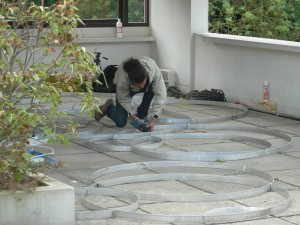
Corbu also designed two buildings at the Cité Internationale Universitaire, a campus housing international students at the University of Paris. The Brazilian Pavilion, being later (1957-59) reminded me of his only North American project, Harvard’s Carpenter Center (1963), where I had the great opportunity to study; the pavilion was extraordinary, even if we were only allowed to visit the extensive (and un-photographable) lobby. We were able to get into one of the rooms, with original furniture, at the Swiss Pavilion (1933, link above), whose sober façade hides much more interesting interiors, which have windows, hence lots of light, in the corridors.
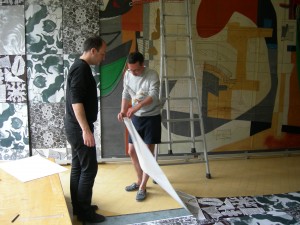
In a ground floor meeting room known as the Salon courbe (Curved Room) we found the Swiss designer, Diego Fellay working with colleagues to hang a wall of black and white printed paper over Le Corbusier’s colorful mural of 1947 as his installation, Wall of Tomorrow ( done in collaboration with the Institut Pasteur, Dimitri de Preux and Matthieu Gadoin). The project, which was opening that evening, was a re-creation of Le Corbusier’s original mural (barely documented and largely forgotten, it was damaged during World War II); it had included images from microbiology and architecture. The temporary return of the original emphasizes the extent to which the architect associated his architecture with organic growth, and perhaps suggests that the famous modular, by which Corbu designed, might be seen as akin to the biological unit of the cell.
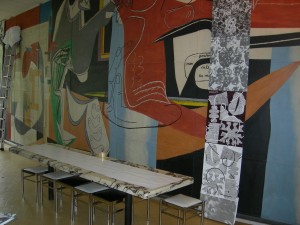
Parole in libertà: Charles Sandison at the Musée du Quai Branly
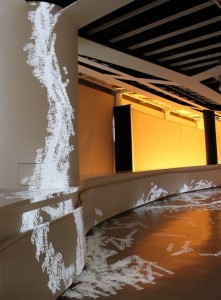
The Scots artist, Charles Sandison, was commissioned last year to create a piece at the Musée du Quai Branly with his favored medium of video projection. The result, The River, is a striking success: a waterfall of words which appears to spill from the ceiling of the long ramp that takes visitors up two floors to the exhibition galleries. As they mount the ramp, the water eddies and flows (yes, uphill; but this is art, and not tied to the realities of hydrology). It is made up of 16, 597 names of the peoples and places represented in the museum, which collects from the continents beyond Europe, with an emphasis on indigenous material (where Europe, it might be noted, is hardly a leader). Occasionally a word will stand out as legible, but largely they move and tumble as a mass in what, undoubtedly, is the artist’s underlying metaphor for mankind. While neither novel nor complex as an idea, the installation itself is extraordinarily effective and turns what otherwise would be a long, uphill slog into an interesting as well as pleasant journey. I’ve seen a fair amount of commissioned artwork that primarily functioned as aesthetic quality control, but whatever criticism I have of Jean Nouvelle’s building and the functionality of the ramp, in particular, Sanderson’s piece is more than that, and valid on its own. I believe it’s a permanent installation; here’s wishing it a long life!


